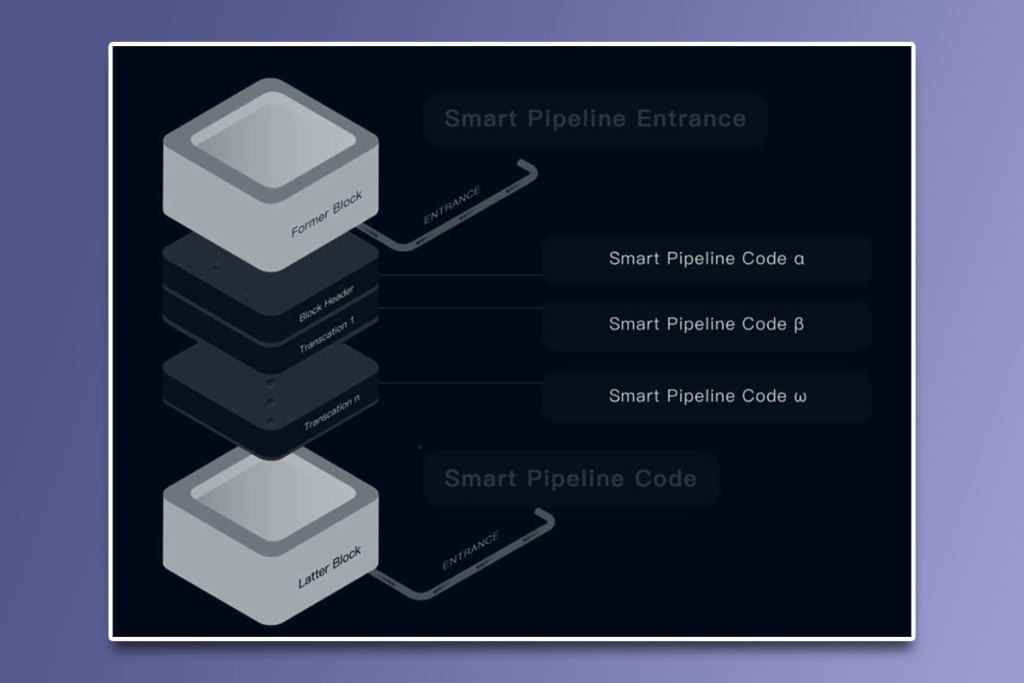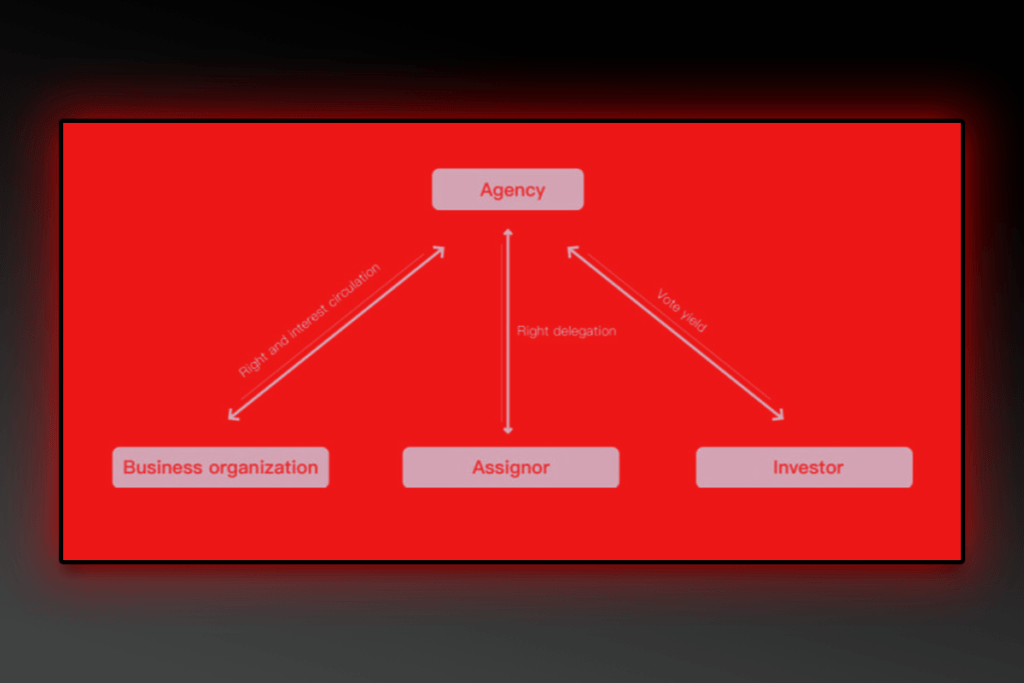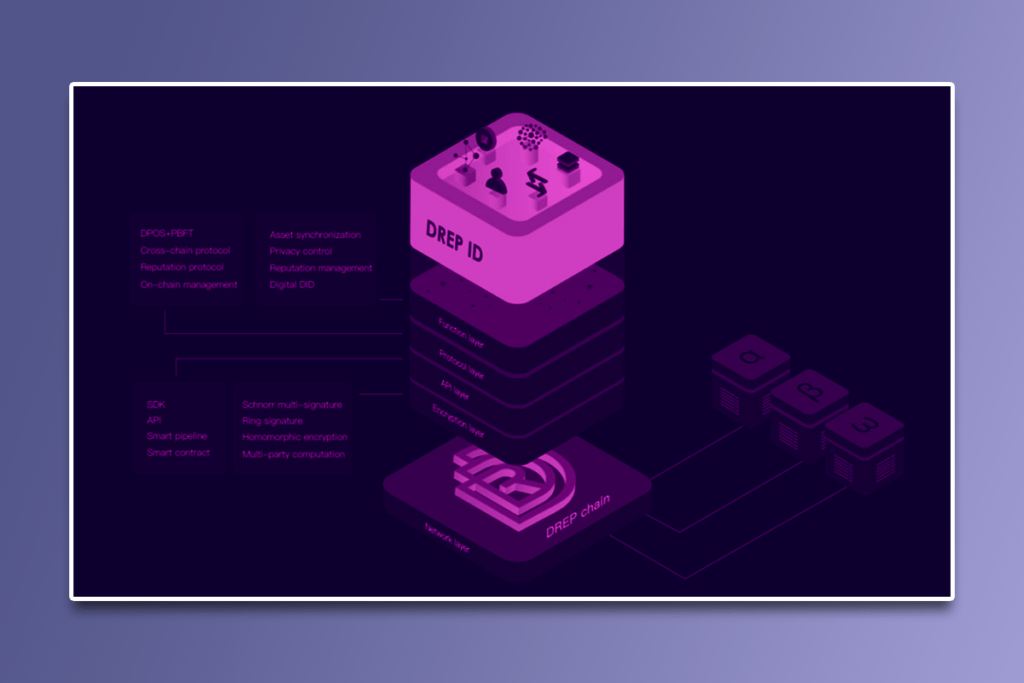DREP’s dedication lies in constructing Blockchain-based Connectors and Toolkits, which offer solutions that enhance usability, adaptability, and seamless integration. By utilizing technologies such as Chain, ID, Reputation Protocol, and SDK, DREP aims to establish an inclusive data ecosystem that challenges the existing separation of users and facilitates the harmonization of fragmented data across multiple chains.
DREP Explained – DeFi Credit Protocol
DREP is devoted to developing Blockchain-based Connectors and Toolkits that offer solutions to enhance user-friendliness, flexibility, and seamless integration. By leveraging technologies such as Chain, ID, Reputation Protocol, and SDK, project aims to establish an open data ecosystem that disrupts the current state of segregated users and harmonizes fragmented data across multiple chains.
As blockchain technology advances, numerous blockchain projects have emerged in the market. However, they are limited by their existing infrastructure, restricting their ability to serve a small number of applications with limited scale and variety.
On the other hand, large enterprises hesitate to adopt blockchain technology in large-scale commercial scenarios, hindering efforts to increase user adoption in the blockchain field.
Project strives to tackle three particular issues:
- Poor performance and development experience of public chains.
- Segregated public chain ecosystem and poor user adoption rate.
- A mismatch between Blockchain technology being developed and enterprises’ needs.

Technical Solutions
The team has developed the DREP Chain, a high-performance public chain, in-house. It is fully compatible with EVM and WASM Smart Contracts and features a dual-layer structure consisting of a root chain and customizable sub-chains.
The team has introduced the innovative Smart Pipeline, which acts as a data transmission pipeline between the blockchain virtual machine and external applications. It efficiently processes data, consumes zero gas, and exhibits strong scalability while prioritizing security. These outcomes cannot be achieved using Smart Contracts alone.
DREP implements the Schnorr Multi-Signature Algorithm, based on the Secp256k1 elliptic curve, to enhance network efficiency and reduce transmission overheads.
For data connectivity and privacy protection, the project has designed a Decentralized ID (DID) system based on the HMAC algorithm. This system comprises a master ID and multiple sub-IDs, allowing users to manage data and assets across centralized and decentralized platforms through the Client.
To ensure data privacy, DREP Chain utilizes homomorphic encryption to safeguard sensitive user information.
DREP launched the comprehensive DREP Client, offering an easy-to-use tool interface for B-end enterprises and a frictionless service portal for DREP Ecosystem users. It integrates features such as asset management, identity management, application development, and a traffic portal.
To enhance the long-term value of DREP DID, DREP introduced a reputation system, including a general reputation protocol, reputation pipeline interface, reputation data storage and algorithm library, reputation incentive mechanism, reputation account management, and fake account identification mechanism.
To lower the entry barrier and learning costs, the project has developed API, Plug-ins, and SDKs for various vertical markets. These toolkits enable DApp development teams to deploy on multiple public chains simultaneously, with built-in wallets and asset trading platforms. With DREP ID, developers can also attract users from different public chain ecosystems and convert them into users, making Super DApps a feasible reality.
DREP SDK follows a service-oriented architecture similar to Java’s Spring container development. Unlike tightly coupled modules found in most blockchain projects, DREP SDK allows fully decoupled modules and facilitates code refactoring with clearer logic.
DREP Smart Pipeline
The team has introduced the Smart Pipeline, an innovative blockchain application model. This model effectively addresses practical requirements that cannot be fulfilled solely by Smart Contracts, achieving high efficiency, zero gas consumption, and robust scalability while maintaining security.
Unlike widely used Smart Contracts on platforms like Ethereum, which face criticisms such as low data capacity, high gas consumption, and limited active calling functions, the Smart Pipeline overcomes these limitations and promotes the development of large-scale DApps.

The Smart Pipeline acts as a data transmission and transfer channel between the blockchain virtual machine and external applications. In this model, real-time data is transmitted from the blockchain client to an external application through the Smart Pipeline.
The external application processes the data and returns the results to the blockchain client in real-time via the pipeline. Smart Pipelines can be strategically inserted at various stages of the process to enhance execution efficiency.
Advantages of Smart Pipeline
Enhanced Execution: Once deployed on the blockchain, the Smart Pipeline can be automatically triggered based on pre-defined conditions. Unlike Smart Contracts, the Smart Pipeline can handle more intricate conditions and is more resistant to interference, making it more suitable for executing complex transactions.
Gas-Free: When executing an application utilizing Smart Pipelines, no gas is required compared to Smart Contracts. However, this does not imply inefficient resource usage. All Smart Pipeline codes must be open-sourced and subject to supervision.
Additionally, the computing resources consumed by the Smart Pipeline are separate from the corresponding sub-chain and provided by the owner of the Smart Pipeline source code. Therefore, any loopholes in this arrangement would not impact the performance of the associated sub-chain.
Language Flexibility: The Smart Pipeline technology utilizes the WASM virtual machine for transaction execution. Users can write code in different programming languages and compile them into WASM bytecode. As WASM continues to evolve, it will support more languages and improve code efficiency without affecting blockchain execution.
Complex Application Support: Smart Pipeline applications are not constrained by gas limitations, allowing blockchains to support more intricate applications. Blockchains that integrate Smart Pipeline technology can still interact with other applications or services, catering to the needs of large and complex applications that may not be supported by existing blockchains.
Consensus Mechanis
PBFT, a secure and efficient consensus mechanism widely used in consortium chains like Hyperledger, falls short in meeting the consensus efficiency requirements of public chains. In the initial release of DREP Testnet Darwin, the project improves its PBFT consensus mechanism by incorporating the Schnorr Multi-Signature Algorithm.
This enhancement enables the integration of numerous signatures into a single signatory, resulting in improved efficiencies for DREP Chain in terms of storage, network transmission, and other aspects. Consequently, it reduces network transmission overhead.
The DPOS consensus mechanism selects representative nodes to participate in transaction verification and accounting, offering higher performance and faster efficiency. In subsequent versions of the Testnet following Testnet 1.0, the project combines the strengths of both DPOS and PBFT consensus mechanisms. This fusion aims to achieve better fault tolerance, more stable consensus, increased efficiency, and reduced likelihood of forks.
Developer Tool Kits
DREP is committed to providing a comprehensive range of development resources to encourage the development of DApps and sub-chains. These resources include Docker, IDE, and other high-level tools, as well as console and infrastructure support. Additionally, DREP will create test tools such as browsers, faucets, and testnets to assist developers in building applications on the DREP Chain.
DREP Docker offers several advantages, including quick setup, easy installation, and deployment. DREP Console provides programmable and interactive features, supporting script operations, which greatly benefits developers. Furthermore, the RPC interface and JS library can be utilized for various functions such as node access.
Staking Mechanism

DREP token holders who wish to contribute to the verification of transactions on the DREP network have the opportunity to stake their tokens and support nodes in becoming candidate nodes. The staking participant will receive rewards based on the duration and amount of tokens staked.
If the participant needs to use the tokens for other transactions, they can submit a withdrawal request. After the current DBFT cycle, the staked tokens, along with the staking rewards, will be returned to the participant’s wallet.
By actively engaging in the network system through staking, token holders not only enhance network security but also protect their rights as token holders and receive staking rewards.
Without active staking, the held tokens do not provide any rights or benefits from staking. Therefore, the staking economy is a significant trend in the world of cryptocurrencies and is closely connected to every token holder.
Drep Wallet
DREP Wallet is a highly secure Hierarchical Deterministic (HD) wallet designed to manage assets across multiple chains. It offers privacy features and valuable services like cloud-based custodial service.
The current version, DREP Wallet 1.2.0, released in October 2019, supports the management of popular tokens and coins such as BTC, ETH, BNB, and others. As a versatile asset management tool, DREP Wallet enables enterprises to deploy wallet tools quickly across different ecosystems and platforms.
Key Highlights of DREP Wallet:
- Supports multi-chain and multi-currency asset management
- Facilitates cross-chain interactions for seamless transactions
- Provides additional value-added services such as staking and gamification
- Incorporates decentralized private key storage technology
- Implements Digital DID Privacy Protection Technology and Zero Knowledge Proof for enhanced privacy and security
- Utilizes homomorphic encryption and other privacy technologies to further strengthen privacy measures
Drep Bridge

DREP Bridge, developed by DREP, is an exclusive cross-chain digital asset exchange and trading tool. It enables swift, convenient, and secure token swaps across various public chains. With seamless integration into existing platforms, DREP Bridge brings the concept of cross-chain value transfer to life.
This empowers enterprises and users to engage in asset exchange, cross-chain transactions, and cross-chain asset circulation, offering enhanced flexibility and accessibility.
Drep Gamification Tool
DREP Gamification Tool, built on the foundation of DREP SDK, provides developers with a powerful toolkit to create engaging economic models, implement asset consumption scenarios, and enable user-defined operations. Its primary objective is to significantly enhance the token economic system. The tool is designed to be secure, decentralized, and customizable, offering seamless integration possibilities.
The current blockchain gaming industry faces numerous challenges, such as a limited game selection, a small user base, high development costs, and overly simplistic economic systems.
In response to these issues, DREP Gamification Tool offers a range of features including a personalized in-game finance module, a flexible economic system with a staking mechanism, a multi-currency payment SDK, and more. Its purpose is to accelerate the adoption of blockchain games and transform on-chain economic models into a practical reality.
Drep ID

Apart from serving as the digital identity utilized on DREP and collaborative application platforms, DREP ID extends its scope to encompass user-generated digital images across diverse platforms. For individual users, DREP ID serves as the initial gateway to highly secure, private, and convenient digital asset management.
For enterprises, DREP ID streamlines the process of acquiring user traffic and accessing high-quality data. It also offers a shortcut for cross-chain asset interactions, enabling transactions involving a wide range of cryptocurrencies.
Tokenomics

DREP issued a total of 10 billion tokens. The distribution plan for tokens is as follows:
Ecosystem development and utility scenarios: 18%
Community and developer incentives: 15%
Token private sale / pre-sale / public offering: 27.2%
IEO: 10%
Team: 17%
Foundation: 12%
Advisors: 0.8%
To access more wiki articles: cryptodataspace.com















Leave a comment